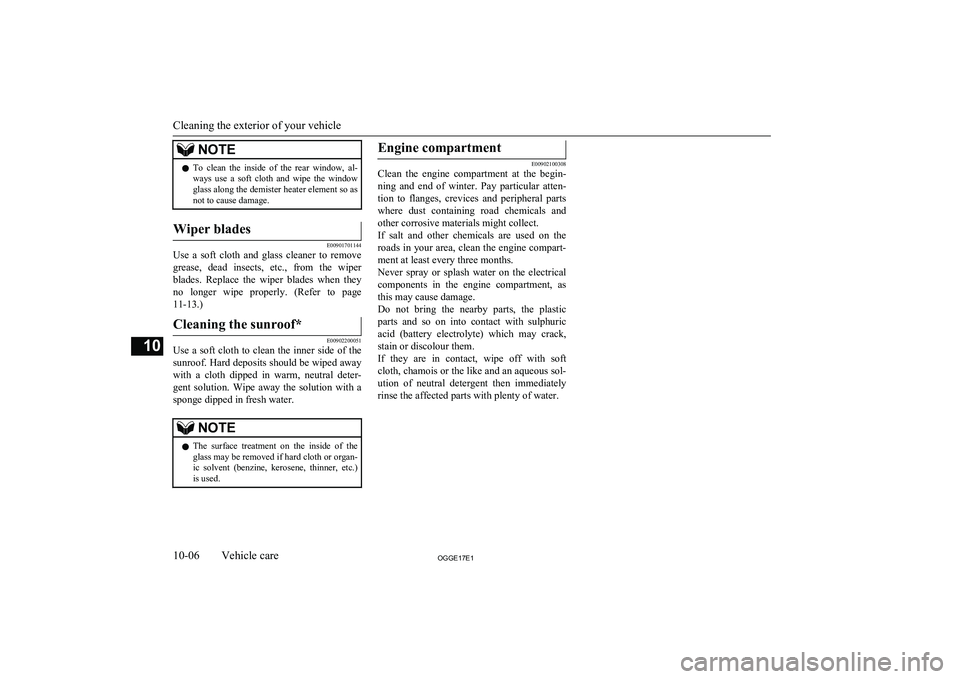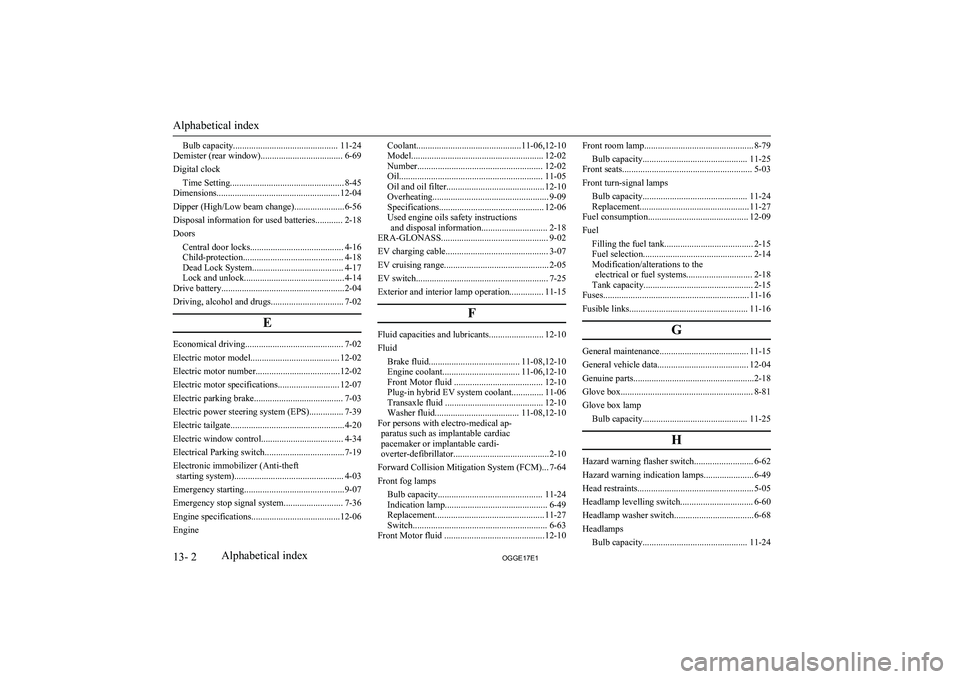dead battery MITSUBISHI OUTLANDER PHEV 2017 Owner's Manual (in English)
[x] Cancel search | Manufacturer: MITSUBISHI, Model Year: 2017, Model line: OUTLANDER PHEV, Model: MITSUBISHI OUTLANDER PHEV 2017Pages: 548, PDF Size: 25.5 MB
Page 83 of 548

Warning activation
E00305901715
In order to prevent vehicle theft or the accidental operation of the keyless operation system, the buzzer and the display on the information screen
in the multi-information display are used to alert the driver.If a warning is activated, always check the vehicle and the keyless operation key. The warning is also displayed if there is a fault in the keyless operation system.
ItemDisplayBuzzerNote (Solution)Detection of failureInner buzzer sounds
once.There is a fault in the keyless operation system.Fall of battery voltageInner buzzer sounds
once.The battery starts to run out, the warning is activated. (The warning is not activated if the battery is completely dead.)Key not detectedInner buzzer sounds
once.When the engine switch is turned to the ACC or ON from OFF
or when the engine is started, the warning is activated, if any of
the following conditions is occurred.
l Carrying another keyless operation key with a different
code, or the keyless operation key could be outside the op- erating range.
l The battery of the keyless operation key is dead.
l Communication is blocked by electric wave environment.Keyless operation key
reminderInner buzzer sounds
about 1 minute.
Outer buzzer sounds
about 3 seconds inter-
mittently.If the operation mode is in OFF and the driver’s door is opened
with the keyless operation key in the key slot, a warning is is-
sued and the outer buzzer sounds for about 3 seconds and the in-
ner buzzer sounds for about 1 minute to remind you to remove
the key. If the key removed from key slot, the buzzer is stopped.
Keyless operation system
4-12OGGE17E1Locking and unlocking4
Page 222 of 548

Seat belts
Before starting the vehicle, make sure that
you and your passengers have fastened your seat belts.
Floor mats
WARNINGl Keep floor mats clear of the pedals by
correctly laying floor mats that are suita-
ble for the vehicle.
To prevent the floor mats from slipping out of position, securely retain them usingthe hook etc.
Note that laying a floor mat over a pedal
or laying one floor mat on top of another can obstruct pedal operation and lead to a
serious accident.Carrying children in the vehi-
cle
l Never leave your vehicle unattended
with the key and children inside the ve-hicle. Children may play with the driv-
ing controls and this could lead to an ac- cident.
l Make sure that infants and small chil-
dren are properly restrained in accord-
ance with the laws and regulations, and
for maximum protection in case of an accident.
l Prevent children from playing in the lug-
gage compartment. It is quite dangerous
to allow them to play there while the ve- hicle is moving.
Loading luggage
When loading luggage, be careful not to load above the height of seats. This is dangerous
not only because rearward vision will be ob- structed, but also the luggage may be projec-ted into the passenger compartment underhard braking.
Parking brake
E00600502918
To park the vehicle, first bring it to a com-plete stop, fully apply the parking brake suf-
ficiently to hold the vehicle.
Make sure the brake warning lamp (red) is il-
luminated.Electric parking brake
E00642100075
The Electric parking brake is the system that
applies the parking brake by the electric mo- tor.
NOTEl You may hear an operation noise from the
vehicle body when operating the Electric
parking brake. This does not indicate a mal-
function and the Electric parking brake is operating normally.
l When the auxiliary battery is weak or dead,
the Electric parking brake cannot be applied
or released. Refer to “Emergency starting” on page 9-07.
l You may feel the brake pedal moving when
operating the Electric parking brake.
This does not indicate a malfunction.
Parking brake
7-03OGGE17E1Starting and driving7
Page 432 of 548

WARNINGlIf any of the check results are not normal,
the red lamp illuminates (for approxi- mately 5 seconds) and the buzzer sounds 3times. In this case, there is a possible fail-
ure in the system. Have the system inspec- ted by a MITSUBISHI MOTORS Au-
thorized Service Point immediately.
6. When the green lamp extinguishes, the
test mode is completed.
If the vehicle breaks down
E00800102408
If the vehicle breaks down on the road, moveit to the shoulder and use the hazard warning
flashers and/or the warning triangle etc.
Refer to “Hazard warning flasher switch” on page 6-62.
If you need to push your vehicle, put the op-
eration mode of the power switch in ON and put the select position in “N” (NEUTRAL) position.
WARNINGl If you are unable to safely assess the vehi-
cle due to vehicle damage, do not touch
the vehicle. Leave the vehicle and contact emergency services. Advise emergency responders that this is a Plug-in Hybrid
Electric vehicle.
If the ready indicator goes out
while driving
Vehicle operation and control are affected if
the ready indicator goes out while driving.
Before moving the vehicle to a safe area, be aware of the following:
l The brake booster may becomes inoper-
ative and the pedal effort will increase.
Press down the brake pedal harder than usual.
l The power steering system may not op-
erate, the steering wheel feels heavy when turning it.
Emergency starting
E00800504204
If the Plug-in Hybrid EV system cannot be
started because the auxiliary battery is weak or dead, the battery from another vehicle can
be used with jumper cables to start the Plug-
in Hybrid EV system.
WARNINGl To start the Plug-in Hybrid EV system us-
ing jumper cables from another vehicle
and perform the correct procedures ac-
cording to the instruction below. Incor- rect procedures could result in a fire, ex-
plosion, electric shock or damage to the vehicles.
l Keep sparks, cigarettes and flames away
from the battery because the battery may produce an explosion.CAUTIONl The Plug-in Hybrid EV system cannot be
started by pulling or pushing the vehicle.
l Check the other vehicle. It must have a 12-
volt battery. If the other system isn’t 12-volt, shorting can damage both vehicles.
l Use the proper cables suitable for the battery
size to prevent overheating of the cables.
l Check the jumper cables for damage and
corrosion before use.
l Always wear protective eye goggles when
working near the battery.
l Keep the battery out of the reach of children.
l Do not attempt jump starting the auxiliary
battery while the drive battery is being charged. Doing so could damage the charg-
ing equipment or the vehicle.
If the vehicle breaks down
9-07OGGE17E1For emergencies9
Page 459 of 548

NOTElTo clean the inside of the rear window, al-
ways use a soft cloth and wipe the window
glass along the demister heater element so as not to cause damage.Wiper blades
E00901701144
Use a soft cloth and glass cleaner to remove
grease, dead insects, etc., from the wiper blades. Replace the wiper blades when they
no longer wipe properly. (Refer to page 11-13.)
Cleaning the sunroof*
E00902200051
Use a soft cloth to clean the inner side of thesunroof. Hard deposits should be wiped away with a cloth dipped in warm, neutral deter- gent solution. Wipe away the solution with a
sponge dipped in fresh water.
NOTEl The surface treatment on the inside of the
glass may be removed if hard cloth or organ-
ic solvent (benzine, kerosene, thinner, etc.) is used.Engine compartment
E00902100308
Clean the engine compartment at the begin-
ning and end of winter. Pay particular atten- tion to flanges, crevices and peripheral parts where dust containing road chemicals and
other corrosive materials might collect.
If salt and other chemicals are used on the roads in your area, clean the engine compart- ment at least every three months.
Never spray or splash water on the electrical
components in the engine compartment, as
this may cause damage.
Do not bring the nearby parts, the plastic parts and so on into contact with sulphuric
acid (battery electrolyte) which may crack,
stain or discolour them.
If they are in contact, wipe off with soft cloth, chamois or the like and an aqueous sol-
ution of neutral detergent then immediately rinse the affected parts with plenty of water.
Cleaning the exterior of your vehicle
10-06OGGE17E1Vehicle care10
Page 505 of 548

Bulb capacity.............................................. 11-24
Demister (rear window).................................... 6-69
Digital clock Time Setting.................................................. 8-45
Dimensions...................................................... 12-04
Dipper (High/Low beam change)......................6-56
Disposal information for used batteries............ 2-18
Doors Central door locks......................................... 4-16
Child-protection............................................ 4-18
Dead Lock System........................................ 4-17
Lock and unlock............................................ 4-14
Drive battery......................................................2-04
Driving, alcohol and drugs................................ 7-02
E
Economical driving........................................... 7-02
Electric motor model....................................... 12-02
Electric motor number.....................................12-02
Electric motor specifications........................... 12-07
Electric parking brake....................................... 7-03
Electric power steering system (EPS)............... 7-39
Electric tailgate..................................................4-20
Electric window control.................................... 4-34
Electrical Parking switch...................................7-19
Electronic immobilizer (Anti-theft starting system)................................................ 4-03
Emergency starting............................................9-07
Emergency stop signal system.......................... 7-36
Engine specifications.......................................12-06
Engine
Coolant..............................................11-06,12-10 Model.......................................................... 12-02
Number....................................................... 12-02
Oil............................................................... 11-05
Oil and oil filter........................................... 12-10
Overheating................................................... 9-09
Specifications.............................................. 12-06
Used engine oils safety instructions and disposal information............................. 2-18
ERA-GLONASS............................................... 9-02
EV charging cable............................................. 3-07
EV cruising range.............................................. 2-05
EV switch.......................................................... 7-25
Exterior and interior lamp operation............... 11-15
F
Fluid capacities and lubricants........................ 12-10
Fluid Brake fluid........................................ 11-08,12-10
Engine coolant.................................. 11-06,12-10
Front Motor fluid ....................................... 12-10
Plug-in hybrid EV system coolant.............. 11-06
Transaxle fluid ........................................... 12-10
Washer fluid..................................... 11-08,12-10
For persons with electro-medical ap- paratus such as implantable cardiac
pacemaker or implantable cardi-
overter-defibrillator..........................................2-10
Forward Collision Mitigation System (FCM)... 7-64
Front fog lamps Bulb capacity.............................................. 11-24
Indication lamp............................................. 6-49
Replacement................................................ 11-27
Switch........................................................... 6-63
Front Motor fluid ............................................12-10
Front room lamp................................................ 8-79
Bulb capacity.............................................. 11-25
Front seats......................................................... 5-03
Front turn-signal lamps Bulb capacity.............................................. 11-24
Replacement................................................ 11-27
Fuel consumption............................................ 12-09
Fuel Filling the fuel tank....................................... 2-15Fuel selection................................................ 2-14Modification/alterations to the electrical or fuel systems............................. 2-18
Tank capacity................................................ 2-15
Fuses................................................................ 11-16
Fusible links.................................................... 11-16
G
General maintenance....................................... 11-15
General vehicle data........................................ 12-04
Genuine parts.....................................................2-18
Glove box.......................................................... 8-81
Glove box lamp Bulb capacity.............................................. 11-25
H
Hazard warning flasher switch.......................... 6-62
Hazard warning indication lamps......................6-49
Head restraints................................................... 5-05
Headlamp levelling switch................................ 6-60
Headlamp washer switch...................................6-68
Headlamps Bulb capacity.............................................. 11-24
Alphabetical index
13- 2 OGGE17E1Alphabetical index